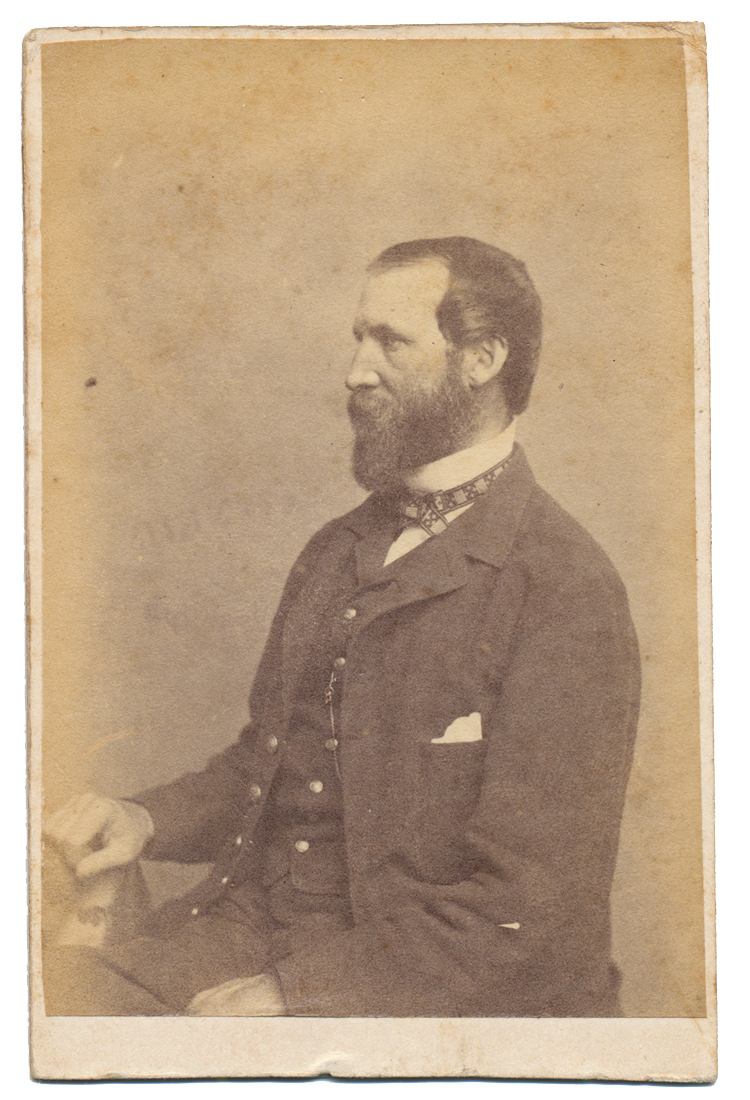site search
online catalog
THREE-QUARTER SEATED VIEW OF GENERAL JOHN G. FOSTER

Hover to zoom
$95.00
Originally $135.00
Quantity Available: 1
Item Code: P14251
Shipping: Determined by Method & Location of buyer
To Order:
Call 717-334-0347,
Fax 717-334-5016, or E-mail
The General is shown in left profile wearing a dark suit with military buttons but no rank insignia. He also sports an interesting neck tie with alternating squares of light and dark material.
Image is clear with good contrast and clarity. Mount and paper are good.
Reverse is blank but for a modern pencil inscription of “GEN FOSTER.”
John G. Foster was born in Whitefield, New Hampshire on May 27, 1823. When he was ten, his family moved to Nashua, where he attended the local schools before enrolling in the Hancock Academy. He graduated from West Point in 1846, fourth in his class of 59 cadets.
He first served as an engineer during the Mexican War, under Winfield Scott. Severely wounded at the Battle of Molino del Rey, he won two brevet promotions for bravery. After the war, Foster returned to West Point as an instructor. In 1858 he was on engineering duty in Charleston Harbor, where he helped in the construction of Fort Sumter.
Promoted to captain of U.S. engineers, Foster was in command of the garrison at Fort Moultrie when the Civil War began. He immediately transferred his small force to Fort Sumter and became second-in-command to Maj. Robert Anderson during the Battle of Fort Sumter. Foster was appointed a brigadier general of volunteers on October 23, 1861, and commanded the 1st Brigade in Maj. Gen. Ambrose Burnside's North Carolina Expedition. He was conspicuous in action at the battles of Roanoke Island and New Bern. After the Battle of Roanoke Island, the Union renamed the Confederate Fort Bartow as Fort Foster in his honor.
After General Burnside was transferred to Virginia, Foster assumed command of the Department of North Carolina. He was promoted to major general of volunteers on July 18, 1862, and led the Goldsboro Expedition. During Confederate Lieutenant General James Longstreet's Tidewater Campaign, upon hearing of a planned Confederate attack on Washington, North Carolina, Foster personally assumed command of its defenses. When D. H. Hill demanded the surrender of Washington, Foster defiantly replied, "If you want Washington, come and get it." Hill's forces besieged the garrison and two Union relief expeditions were turned back. Foster escaped the besieged city in order to personally lead a relief column back. Hill withdrew his forces shortly afterward. Both Confederate and Union forces burned down much of the town. In December, Foster led the Goldsboro campaign won two minor battles at Kinston and Goldsboro against inferior Confederate forces led by Brigadier General Nathan G. Evans, resulting in the shutdown of the vital Confederate supply line of the Wilmington and Weldon Railroad for merely two weeks.
In December 1863, Foster was sent to Tennessee to assume command of the Department of the Ohio and its corresponding Army of the Ohio. He was in command for only a short time before he was badly injured in a fall from his horse. Upon his recovery, he took command of the Department of the South and aided in forcing the surrender of Savannah, Georgia. He was making preparations for the surrender of Charleston, but his wounds forced him to relinquish command to Maj. Gen. Quincy A. Gilmore.
Foster was assigned to command of the Department of Florida at the end of the war, receiving a promotion to the rank of major general in the volunteer service and brevet major general in the regular army.
After the war, Foster remained in the army, being promoted to lieutenant colonel of engineers in 1867. Promoted to colonel of engineers in 1871, he was involved in military and underwater surveying. He became an expert in underwater demolition, publishing a definitive manual on the subject in 1869 that became the acknowledged reference work. From 1871 until 1874, he was assistant to the Chief of Engineers in Washington, D.C. His final post was as superintendent of the Harbor of Refuge on Lake Erie.
Foster died in Nashua, New Hampshire, and was buried in Nashua Cemetery. The first official reunion of the New Hampshire Veterans Association, which took place in Manchester, New Hampshire in October 1875, was named Camp J.G. Foster. [ad]
~~~~~~~~~~~~~~~~~~~~~~~~~~~~~~~~~
THIS ITEM, AS WITH ALL OTHER ITEMS AVAILABLE ON OUR WEB SITE,
MAY BE PURCHASED THROUGH OUR LAYAWAY PROGRAM.
FOR OUR POLICIES AND TERMS,
CLICK ON ‘CONTACT US’ AT THE TOP OF ANY PAGE ON THE SITE,
THEN ON ‘LAYAWAY POLICY’.
THANK YOU!
Inquire About THREE-QUARTER SEATED VIEW OF GENERAL JOHN G. FOSTER
Most Popular
Historical Firearms Stolen From The National Civil War Museum In Harrisburg, Pa »
Theft From Gravesite Of Gen. John Reynolds »
Selection Of Unframed Prints By Don Troiani »
Fine Condition Brass Infantry Bugle Insignia »
Large English Bowie Knife With Sheath 1870’S – 1880’S »
Imported (Clauberg) Us Model 1860 Light Cavalry Officer's Saber »
featured item
LARGE FRAMED RELIC SHOWBOARD
This relic board is very like those assembled from Gettysburg relics by John Rosensteel and displayed on the porch of the Round Top Museum, but differs in displaying the relics on horizontal rather than raw vertical boards, in having a glass frame,… (1242-06). Learn More »


